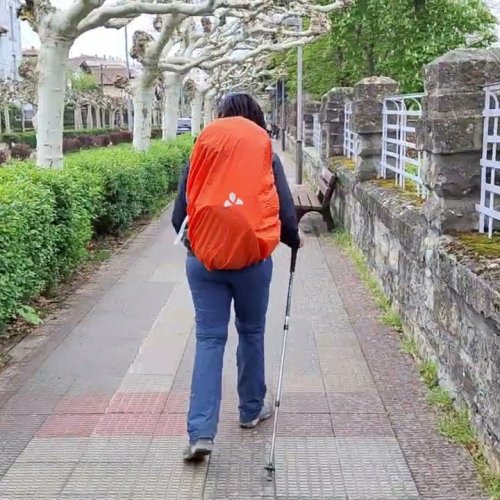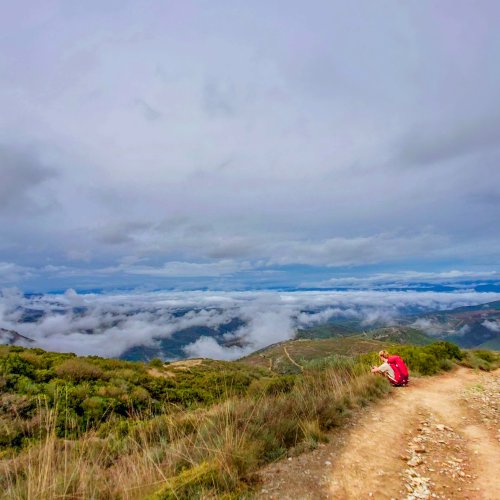A warm welcome to the Forum

American Pilgrims on the Camino (APOC) has a nice
FAQs about a pilgrimage on a Camino which may give you some additional help.
The good news is, you are in a forum with a wonderful group of people. Most are here to help people like you to achieve their pilgrimage goals. We can offer you encouragement, knowledge, and point you in the direction that will help you help yourself.
My suggestion to start is this:
- Take a deep breath. Write down in large letters the reasons why you want to go on Camino. Place that piece of paper where you can see it every day. That way, if anxieties and fears threaten to overwhelm you as you plan, you can just breath, read what you have written, and focus on those reasons until the negative stuff fades.
- Make a list of questions and concerns that you have.
- Go to the Search Engine at the top of the Forum pages.
- Enter the words or phrase that you want more information about. You will get a huge amount of information to explore.
- If you find that you need help with anything, post a new thread so that your question or concern can be readily seen. If you post a question within someone else's thread, you won't receive as big of a response.
- Remember that perfect timing as it relates to how you feel, scheduling, and day to day life issues, seldom align themselves perfectly. If one waits for such to occur, doing something like a pilgrimage will always be in danger of taking a back seat while you wait for that perfect alignment to happen.
--------------------------------------------------------------
I can share with you the quick basics I follow when I train, that way you can apply the principals for your own individual needs, physical conditions, and limitations.
[NOTE: Before undertaking any change in activity level or exercise, be sure to check with your medical provider first. Even a quick phone call informing him/her of your plans will allow your provider to give you any guidance that is deemed important.
]
There are two parts to how I train:
- Cardiovascular fitness.
- Muscle strengthening.
With both parts to an exercise plan, it is far better to go slower and be more deliberate and committed to your fitness time, than to overdo it by rushing the exercises and risking overuse injuries and becoming discouraged. Using THR zones, you will always make progress even though you take more time to reach your goal.
Cardiovascular fitness is the ability for the heart and lungs to supply oxygenated blood to your muscles during exercise while under load, and your muscles ability to use that oxygen efficiently so they can produce energy.
A valuable and important tool that is easy and good to follow for developing cardio capacity is the concept of Target Heart Rate zones (THR). It doesn't matter what your fitness level is, THZ will allow each person to develop at their own speed and point of fitness.
Exercises should be used which will allow you to hit a target heart rate (THR) zone, over a set period of time during exercising, which provides the needed aerobic effort for conditioning. This is a website which will help you calculate what your target heart rate zones will be.
https://www.lifespanfitness.com/fitness/resources/target-heart-rate-calculator
Treadmills at incline, running, walking at a faster than normal pace, walking up hills, using rowing machines, HIIT (High Intensity Interval Training) workouts, riding a bicycle at a faster than normal pace, swimming, etc. are all examples of effective aerobic exercises when used to achieve target heart rates.
Keep in mind that as your fitness level improves, it will take a more sustained effort to hit the same heart rate zones. That is why using THR zones is so effective. They don't change relative to one's fitness level. Someone extremely out of shape who cannot exercise as hard and as long as someone who is extremely fit, will still reach the exact same THR during their exercise sessions. It takes more intensity in training for the person who has a great fitness level to reach 140 heart beats per minute (BPM). An out-of-fitness individual will reach that same 140 BPM in a far shorter amount of time and with far less intensity to the exercise.
As you gain fitness, it will take a longer period of exercise and a harder effort at the exercise to keep reaching 140 BPM. It is this THR phenomenon which allows a person to use their own fitness levels as a guide to steady progress rather than relying on some formula laid out by someone who doesn't know you from a hill of beans.
This is what I do for Cardio. It is based on MY current fitness level as an example of how to use what you have around you as an exercise resource. You do not need a gym membership.
During most of the year, I alternate days of effort and length during the week. Every other day I do a Long Loop Trail which is about 7.5 miles in length and gains a total of 2800 feet in elevation. During the other two or three days, I do the Short Loop Trail, which is 3.8 miles in length and only gains 1215 feet of elevation. When I am up backpacking, that will, of course, serve as a daily workout.
For really crummy weather days --- and lately over the last four weeks when smoke from wildfires made the air hazardous for outdoor activity --- I use a treadmill that can achieve a 30 degree incline, and which I spent a bit of time carefully calibrating to make sure it is reasonably accurate for both speed and incline settings. If I didn't have a treadmill, I could jump rope, stair step, run in place, etc. A lot of times the local high school will let the folks in the district use their facilities.
I decided that I would save money by using a treadmill at home -- not to mention the convenience -- rather than paying a gym membership to use
THEIR treadmill. It wasn't cheap, but I now have over 7100 miles on it over the course of several years. I learned how to maintain it and keep it accurate in it's measurements. Having the treadmill at home actually decreases the amount of time spent exercising by eliminating the 'getting to and coming back' from a gym.
Muscle strength is a function of how much maximum force your muscles can exert against resistance. Exercises for strength will
also provide a temporary aerobic cardio-vascular workout and effect, but the main goal is to increase your capability to function while under resistance.
Think about having to lift the weight of your body, with a pack, with each step going up the Pyrenees. Or being able to lift and carry a load. Or the constant resistance of your body weight and pack to your shoulders and to the 'core' muscles in your back and abdomen.
Some basic strengthening exercises for home include:
- push-ups
- lunges
- squats
- planks.
Rather than try and describe the steps involved in properly doing each exercise, do a google search to show you the way to do these exercises.
Again, make steady progress NOT quick progress. The goal is to keep you injury free while you are getting stronger.
This is what I do for strength training and core conditioning. Again, take it easy and build gradually.
In addition to the exercises I listed, I use two pieces of equipment:
- A cheap set of dumb bells
- A TRX strap system.
Again, Google will provide and describe and show the basic exercises for this type of equipment. The TRX system is an offshoot of what several folks used in the military while in combat zones where there is no weight lifting equipment. Back then, it was cargo webbing straps. From that, someone made a gazillion dollars with a nicer, more modern iteration all nicely packaged up and all professional looking

Why didn't I think of doing that?
 Other conditioning issues
Other conditioning issues involve things like ankles, feet, and flexibility. Do a search on this forum for posts I have made about exercises to help prevent shin splints and to help prevent plantars fasciitis.
Regardless of which exercises you are doing, include frequent walks. Not workouts ... just walk at a comfortable pace and for a comfortable period of time. Use this opportunity to try out footwear for Camino. Look for the beginning niggling of potential problems with your feet and joints so that you have plenty of time to have them looked at by a provider and deal with any treatment plan.
After you've been involved in your fitness regimen for about three months, put on the clothing and footwear you will be using on Camino, load up your pack, and for several days in a row walk for a 3 to 4 hour period. See how you feel and at what pace you are able to best sustain yourself. That will give you a baseline estimate to calculate logistical issues surrounding the question of how far can I comfortably walk within a given amount of time. If you feel you need more time with conditioning before doing that type of walking, then wait for another month or two.
Yes, things and conditions can be different once you are on Camino as the unexpected arises, but those walks will help not only give you some insight and guidance, but also help build your confidence.
It will also let you know how your feet, knees, back and shoulders are doing.
More than anything else, enjoy the entire process of getting ready for Camino. Keep thinking about your personal goals for doing Camino and what type of experience you are hoping for. Also, think about what you can contribute, as a pilgrim, to the spirit and nature of the Camino when you begin your first steps toward Santiago.
















